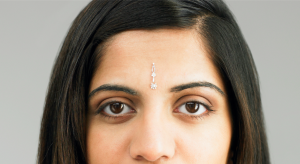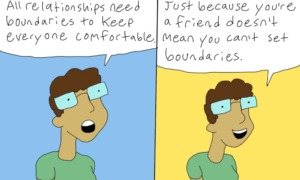
A person in the foreground looks down sadly while three people in the background stare skeptically.
(Content Warning: sexual violence)
A few hours after the Trump/Billy Bush tape dropped, my longtime Democrat dad called.
We had been nonstop election-chatting for months. But this time, he had a question that sincerely puzzled him: How could anyone still vote for Trump after seeing that Access Hollywood clip?
He really thought that this tape would be a deal-breaker, particularly for women who remained in the Trump camp. But I wasn’t so certain.
To be sure, that tape definitely had an impact on some voters, as did the seemingly endless stream of women who came forward to accuse Trump not only of horrific language, but also of physical violations. However, many of Trump’s supporters continued to speak to the appeal of his personality or policies, or about their distrust of Hillary.
A group of women convened by CNN offered unwavering endorsements with all manner of excuses, from “Boys will be boys,” to “I’ve heard a lot worse,” to “It would have been different if he had said it with women present.”
But while none of the women interviewed for that segment gave it, there was yet another sadly common reason behind the dismissal of the behavior: a belief in rape myths and the “othering” of survivors of sexual violence.
That’s something that is pretty common. Yet, since we live in a world where women, trans and gender non-conforming, and queer folk exist under the constant threat of sexual violence, it isn’t surprising that a lot of folks need to separate themselves from victims, or blame victims for their experiences.
And really, most of the time, this isn’t solely a nefarious act of cruelty. For a lot of us, it’s more a survival tactic, something we do to make the very act of leaving the house less scary a prospect.
But because many of us unwittingly fall into this trap of victim-blaming and “othering,” it’s really important to identify what’s going on, and then to consider the ways that we can subvert this tendency.
Doing so will help us figure out how to feel safe in the world without turning on survivors in the process, and it is one of the many ways we can work towards challenging the social norms which allow even a candidate for the highest elected office to get away with such behaviors.
So with that in mind, here are a few points you need to know.
1. Rape Culture Is Built on Sexual Objectification and Sustained By Rape Myths
Feminist writer Laurie Penny explains in her book, Unspeakable Things: Sex, Lies, and Revolution:
“Sexual objectification doesn’t get oppressive until it is done consistently, and to a specific group of people, and with no regard whatsoever paid to their humanity. Then it ceases to become about desire and starts to be about control.
“Seeing another person as meat and fat and bone and nothing else gives you power over them, if only for an instant. Structural sexual objectification of women draws that instant out into an entire matrix of hurt. It tells us that women are bodies first, idealized, subservient bodies, and men are not.”
As Penny asserts, and as the Access Hollywood tape reminds us, sexual objectification is a structural issue. It is one that clearly affects gender minorities like women and trans folks.
Really, the fact that someone who so blatantly embraced such a view could still capture as many votes as Trump did is a is proof positive that to a lot of Americans, women (and anyone else viewed as less-than because they’re not cisgender men) aren’t actually humans.
Rather, as Penny asserts, they are considered objects in a way that cis men simply aren’t.
2. Blaming as a Form of Self-Preservation
Many of us learn learn from day one that the world is a scary place, and that there are things we can do to protect ourselves.
LGBTQIA+ folks are told to hide their queerness in order to stay safe. And girls of all identities are warned against talking to strangers, wearing something revealing, or sending boys “mixed signals.”
And even though I try to challenge such logic, I too can find it comforting.
For example, recently, my ten-year-old daughter was about to embark on her first solo train trip to see an aunt. All was fine until I began a litany of warnings about the journey: “Keep your new flip phone out and call me if anyone weird talks to you. Put your bag next to you so no one sits there. If a man takes the seat beside you, move.”
Despite knowing that the vast majority of sexual assaults are not stranger-driven, that self-defense tactics can only do so much to protect ourselves from danger, that setting my child up to be afraid simply fueled the fires of the rape culture we live in, I presented her with this grim advice in a moment of parental panic and unwittingly reinforced the rape myths I so desperately want to dismantle.
Needless to say, she arrived safely, if a little unsettled.
But what should be unsettling is that like the rest of us, my daughter inhabits a world that still tells us that we are responsible for preventing our own rapes.
This means that if you are among the one in six American women who will experience sexual assault in their lifetime – or the 10% of survivors who are men – you are often blamed for the occurrence of an assault (unless you fit into some extremely unlikely stranger-in-a-dark-alley narrative). It also means that you’re likely to blame yourself when it happens.
Whether this blaming is justified by a belief in rape myths, or if, as one study found, it occurs as a way to maintain a sense of control over one’s own life, or whether it is driven by the “just world belief” (which holds that people get what they deserve), adhering to such a view is often a defense mechanism which enables us to “other” rape survivors, in order to tell ourselves that we have the power to avoid joining their ranks.
3. A New Way to Navigate Rape Culture
Even though we might have rational reasons for believing rape myths, for “othering” survivors, or for being rape culture apologists, doing allows such a culture to thrive.
And this is a culture that trades on the fears of those it oppresses and uses these fears as a way to prevent our full participation in all aspects of public life, while also continuing the objectification of women and the subjugation of queer folk.
Ultimately, we need to work to dismantle rape culture – even though doing so is no easy thing.
But when we think about the benefits to us and those around us, examine the current state of the world and country, and ask if we really can afford to take even one step back when there are still so many more steps forward that are need, the answer seems clear.
Doing so will help us both be safer and also feel safer. It will help us avoid falling into the trap of casual victim blaming and othering, and it will challenge the reliance on some half-assed version of empowerment (Carry a rape whistle! Better yet, carry a gun!) that simply doesn’t do anything other than provide a false sense of security and once again puts the onus on those who would be harmed rather than those who might do that harm.
***
But calling for the dismantling of rape culture is a lot easier said than done.
So here are four real ways to get started:
1. If You’re a Parent, Reframe How You Present Safety to Your Kids
One of the most inspiring things I’ve seen comes from a parent named Erin Runnion.
Runnion’s five-year-old daughter was abducted, sexually assaulted, and murdered by a stranger in 2002. After this tragedy, Runnion founded an organization called The Joyful Child to help prevent child sexual abuse.
But despite her own horrific experience, Runnion doesn’t emphasize the risk of stranger danger, as this is something she knows is relatively rare.
As she explained in an interview:
“The problem with ‘stranger danger’ is that it just addresses tiniest portion of the problem when abusers are normally someone the family knows and trusts. We don’t need to frame this as though the boogeyman is out there to get you.
“Children don’t respond well to fear. Children need to know that whatever they tell you, you will always love them.”
Runnion’s tactic doesn’t make the entire world a scary place.
Rather, it teaches children skills needed to actually address the places they are most likely to encounter sexual violence, and it gives them permission to seek help from a parent when needed.
2. Do What You Need to Do to Feel Safe in the World
Despite the fact that a sexual assault is never a survivor’s fault, that doesn’t mean that we should fault people for doing things that make them feel safer out there in the world.
If that means walking a different route than you might otherwise, faking a phone call to a friend when feeling uncomfortable, jogging outdoors with only one earbud in, budgeting for a cab, or only traveling with another person, do that.
A number of cities offer safe-ride programs for women and LGBTQIA+ folk. And college campuses may offer safe walk-home programs, as well. Look into those if it will help you feel better about getting home at night.
3. Remind Yourself That There Is No One Way
There are many ways to be in this world, and the ways we work to feel safe from sexual violence will be different for everyone.
Some people need to claim space, marching in Walks Against Rape Culture, Take Back the Night rallies, or Pride parades. Others feel more secure taking a quieter role and staying under the radar.
Know yourself and don’t feel like you need to push the boundaries of your comfort levels publicly if that just isn’t your thing.
4. Work to Dismantle Rape Culture
There are a range of ways that we can work to dismantle rape culture.
For example, we can reject traditional gender norms that encourage victim blaming and a violent interpretation of masculinity. We can support consent education and practice affirmative consent ourselves.
We can become media literate and understand that what we see and read is not always an accurate portrayal of sexuality. We can also speak up about our own experiences with sexual assault and challenge the rape myths that so often allow us to disbelieve survivors’ stories.
Rape culture is real, but what is also real is the progress that has been made simply by chipping away at its foundation.
***
This recent election has left many of us shattered. But it has also pushed a lot of people to acknowledge the omnipresence of some pretty significant structural inequalities built into the world we inhabit.
One of these is rape culture, something that can take a lot of complicated mental gymnastics to navigate. The result of these gymnastics is that, consciously or not, a lot of people assume that survivors of sexual violence either did something to provoke attacks and/or could have done something different to avoid them.
But if the last few months have shown us anything, it is that the sexualization of women and other marginalized people continues to be a looming threat – and that, while it can be tempting, overlooking sexual violence, dismissing its impact, and absolving its perpetrators won’t keep us safe.
But once we realize that such practices don’t occur in a vacuum, but rather are fueled by the myths that sustain this environment and the desire to give ourselves some measure of psychological protection, we can work to create a new truth: one in which our sense of safety doesn’t have to come at the expense of anyone else’s trauma.
[do_widget id=’text-101′]
Ellen Friedrichs is a Contributing Writer for Everyday Feminism. She’s a health educator, sometimes writer, and mom. She has worked at Manhattan’s Museum of Sex, developed sex education curricula in Mumbai, India, and run HIV prevention programs for at-risk teens in the South Bronx. Currently, Ellen runs a middle and high school health education program and teaches human sexuality at Brooklyn College. More of Ellen’s writing can be found here and here. Follow her on Twitter @ellenkatef.
Search our 3000+ articles!
Read our articles about:
Our online racial justice training
Used by hundreds of universities, non-profits, and businesses.
Click to learn more
Most Read Articles
- « Previous
- 1
- …
- 30
- 31
- 32



















